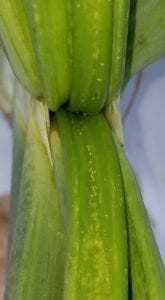Agronomic Crops
We certainly got our fair share of rain the in last few weeks, but we have also seen a significant increase in temperature just in the last week. Given the warmer weather, slugs may feed on young corn and soybean plants at night and early in the morning but will likely retreat to the soil or under crop residue during the day. The black cutworm was still active in corn, although as some of the corn fields we are scouting are approaching V7, the feeding has not been as severe as compared to some fields that are VE through V3. Black cutworms are much less likely to cut plants at the V4 stage and beyond. Many of the soybean fields in the area are beginning to emerge. We are typically seeing plant maturity anywhere from sprouts to VC (unrolled unifoliolate leaves). We are beginning to find some potato leaf hoppers in the alfalfa. Remember that the best way to scout and check for leaf hopper populations is to use a sweep net. The threshold for potato leaf hoppers is based on the alfalfa height in inches and the number of leaf hoppers per 10 sweeps. If you have more leafhoppers in 10 sweeps than the height of the alfalfa, then you are over threshold.
Vegetable Crops
The Colorado Potato Beetle larvae have hatched and are now feeding in both potato and eggplant. When approaching plants to look for them, be cautious. When the beetle is startled, they drop to the ground and may be difficult to see. They do significant damage to the foliage and can cause significant reduction in yield. The Colorado Potato Beetle also has a history of developing resistance to insecticides being used as control measures. This has limited our choices for treatment options. The best way to prevent further resistance is to avoid using the same insecticide repeatedly. At the current plant stage for potato, the threshold is approximately 1 beetle per plant. For eggplant, it is 25 beetles per 50 plants.
In summer squash/zucchini, we are seeing an increase in the number of cucumber beetles. The seed treatment on these plants is beginning to wear off. For fall vine crops that have just been planted in the last few weeks, that seed treatment should still have a few weeks of efficacy left.
In onions, we have noticed an increase in the number of thrips, in many cases approaching an action threshold. Threshold is 25-30 thrips per plant. This week we also found more incidences of slippery skin which was confirmed by the vegetable pathology lab at OARDC earlier this month. Slippery skin is caused by Pseudomonas gladioli. This bacterium is spread via soil splashing from heavy rains and enters the plant through natural openings or openings from mechanical injury. Given the heavy rains we have experienced in the past week, it would probably be a good idea to get out and check your onions.
Overall, tomatoes are continuing to grow rapidly in the greater Wayne County area, with some plantings of field tomatoes beginning to set blooms. We did have a case of timber rot identified in the West Salem area in field tomato. It is important to practice good crop rotations and rotate out of a crop family completely for at least 3-4 years. A complete crop rotation will help to break up disease and pest cycles. Similar to onions, tomatoes can contract bacterial diseases from soil splashing. If you have tomatoes, it may be worthwhile checking the lower canopy of your plants to monitor the presence of any diseases.
Our IPM pest scouts have continued to find Mexican bean leaf beetles in the green beans this week. Light foliar feeding was observed.
With the warmer weather and plants maturing rapidly, the slug threat has greatly reduced in the last week. Any new transplants should still be monitored for feeding, however there should be less of a slug presence for the rest of the growing season.
Small Fruit and Orchards
This week we continued to find aphids in apple trees. Our IPM program identified populations of green apple aphids in several orchards as well as a case of wooly apple aphids. Both aphid species can cause significant damage at this time of year. Accordingly, diligent scouting is a crucial aspect to not allowing either of these aphid species from getting out of hand. The heavy rains likely knocked back some of these aphid populations, but it will be important to monitor aphid populations as the weather dries out a bit.
In apples, we continued to so find a few instances of fire blight. Conditions have been ideal for fire blight development, so it is not much of a surprise to see some cases.
We have had sustained catches (over threshold) of both Codling Moth and Oriental Fruit Moth in apple and peach orchards, respectively. Over the last week, both Codling Moth and Oriental Fruit Moth populations have been trending downward, however, numbers have still exceeded the action thresholds.
With the storms over the course of the last week, it is not unlikely that we will see some yield loss from wind, heavy rains, or hail damage in many of the area’s fruit trees.
Now is the time to be managing early season diseases in apples. Scab, rust and powdery mildew are the three main diseases of concern at this point in the season.
Strawberry leaf diseases may appear unsightly right now, however, now is not the time to be managing these leaf diseases. Once harvest is done and during patch renovation it is recommended that you address these concerns, either with a fungicide or with resistant plant varieties. This is also a critical time to be watching for fruit rots such as Botrytis.
Grapes are currently around the buckshot berry stage. It is still possible to spray for and manage black rot during this time.



















